[ad_1]
Verdict
The Xiaomi Redmi Pad SE gives a tidy full-sized pill at a sub-£200 price ticket, however the compromises to efficiency imply that its use is proscribed past media streaming and lightweight internet searching.
Execs
- Clean 90Hz refresh price
- Two years of OS upgrades
- Premium aluminium construct
Cons
- Snapdragon 680 isn’t one of the best
- Very gradual 10W charging
- Pretty low decision for an 11-inch show
-
Unusually easy showNot many sub-£200 tablets boast a display refresh price above 60Hz, however the Redmi Pad SE hits 90Hz. -
Luggage of enlargement potentialYou’ll be able to develop the Pad SE’s storage by as much as 1TB utilizing a microSD card. -
Epic staminaWith a larger-than-average 8000mAh battery, the Redmi Pad SE can final days on a single cost.
Introduction
It was that one of the best you would hope for from a sub-£200 pill was for it to not be terrible. The Xiaomi Redmi Pad SE most actually isn’t that.
It is a full-sized, entertainment-focused Android pill expertise with a premium design, all for simply £199. With some eye-catching media-friendly options, it could possibly be all of the pill that most individuals want – at the least on paper.
How about in follow? That’s what we’re right here to search out out. In gunning for a really useful retail value that’s even cheaper than the Oppo Pad Air and the Samsung Galaxy Tab A8, has Xiaomi’s finances model minimize too deep in pursuit of low-cost thrills?
Design
- All-metal design
- 7.36mm skinny
- Weighs 478g
The Xiaomi Redmi Pad SE is a properly constructed full-sized pill which may have you ever elevating your eyebrows in shock if you see the worth tag, at the least if you happen to weren’t conscious of the Oppo Pad Air or the Samsung Galaxy Tab A8 earlier than it.
It’s really now fairly regular to have a £200-ish pill with a slim all-aluminium body, and the Redmi Pad SE appears to be like rather a lot like these two opponents. It doesn’t actually have any distinctive design flourish to mark it aside, aside from the delicate Redmi branding on the rear, but it surely actually appears to be like sensible.
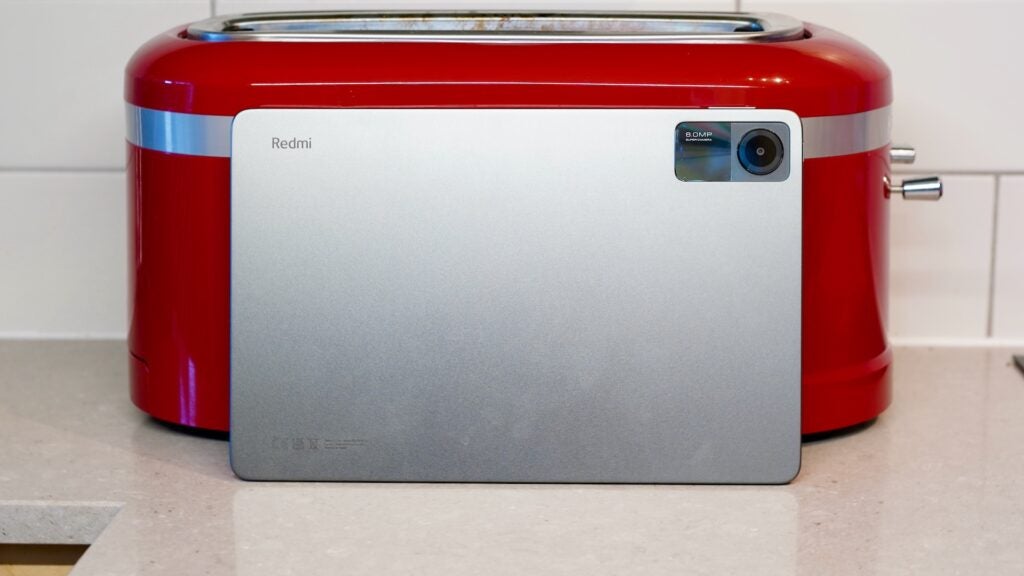
It helps that it is available in three colors, two of which (Lavender Purple and Mint Inexperienced) are fairly attention-grabbing for an inexpensive pill. Usually, I used to be despatched the Graphite Grey mannequin, which is far more skilled (learn: boring) trying.
The entrance of the pill appears to be like much more generic, in fact, with nothing however a uniform bezel working round an 11-inch show. These bezels are comparatively slim, with the Redmi Pad SE boasting an 84.4% screen-to-body ratio, which pips the Oppo by a single proportion level.
Nonetheless, at 7.36mm thick and weighing 478g, it’s not fairly as slim and lightweight because the Oppo Pad Air, which weighs in at 6.9mm and 440g respectively. Even so, Redmi’s pill is nice to carry – or quite, prop in your lap, as is extra typically the case with these bigger tablets.
Display
- 11-inch IPS LCD
- 1920 x 1200 decision
- 90Hz refresh price
The Xiaomi Redmi Pad SE packs an 11-inch IPS LCD, and it’s a strong performer.
With a decision of 1920 x 1200, it’s not as pixel-dense because the Samsung Galaxy Tab A8’s smaller display, and even much less so not the Oppo Pad Air’s 10.36-inch 2000 x 1200 panel. It’s lots sharp sufficient for Full HD video streaming and internet searching although, which is what you’ll be doing more often than not.
With a prime brightness of 400 nits, it will get about as vibrant as its equally priced rivals. That’s superb for indoor viewing, however you wouldn’t wish to take it out within the backyard on a sunny day. Don’t anticipate it to shine with HDR content material, both.
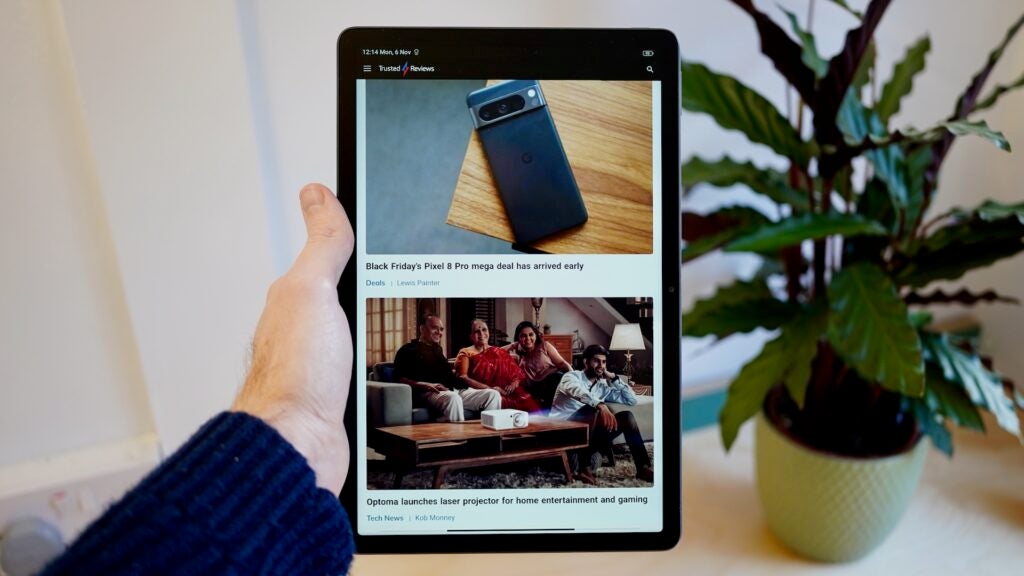
The most important benefit the Redmi Pad SE show has over its rivals is a 90Hz refresh price, which suggests it’s 50% smoother than that of the Samsung Galaxy Tab A8 and the Oppo Pad Air. That’s a giant plus level, although there may be an argument to be made that the restricted efficiency of those £200 tablets considerably negates the impact of a better refresh price.
These low-cost full-sized tablets are very a lot meant to be transportable media gamers, in fact, so it’s acceptable that we convey audio into the dialog right here. The Redmi Pad SE provides you a robust quad-speaker set-up that helps Dolby Atmos output, and it gives impressively loud, punchy sound for the worth.
You additionally get a 3.5mm headphone jack alongside the USB-C port for these bodily headphones connections, although it’s disconcertingly positioned proper close to one of many edges, which quite jogged my memory of these events the place you’d mess up and misalign with the opening punch at college or work.
Efficiency
- Snapdragon 680
- 4GB LPDDR4X RAM
- 128GB storage, microSDXC enlargement
Identical to the Oppo Pad Air, the Xiaomi Redmi Pad SE runs on Qualcomm’s Snapdragon 680. Identical to that rival, it’s not fairly sufficient to offer a sufficiently fluid expertise.
It’s not that the pill is incapable of working explicit apps or duties. Should you’re spending this little on a pill and anticipating it to play Genshin Impression easily, then you want to reconfigure your expectations, or else be ready to double your finances.
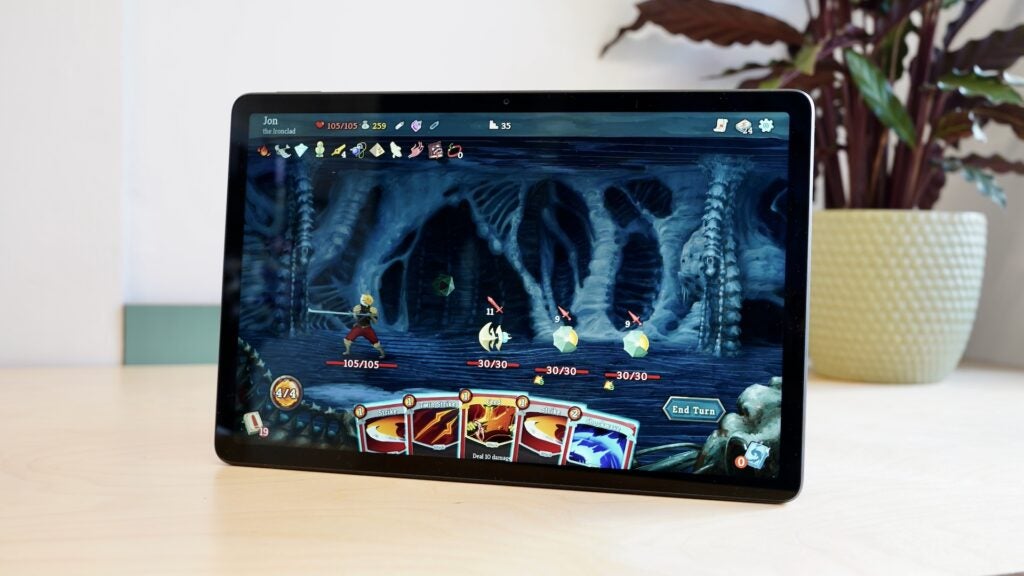
My subject with the Snapdragon 680, at the least inside this context, is that it struggles to do even the fundamentals easily. Whether or not you’re waking the pill from sleep, hopping between apps, or just scrolling by way of internet content material, there’s a noticeable lag to all the things, with frequent micro-stutters breaking the sense that you simply’re coping with a fairly stylish pill.
In comparison with the Oppo Pad Air, the Redmi Pad SE has the good thing about driving a lower-resolution show. Conversely, it boasts a a lot quicker 90Hz refresh price which, as hinted at earlier, it could actually’t fairly benefit from.
Even so, give the Redmi Pad SE a single easy media-based job to execute and it’ll accomplish that admirably. For taking part in a film on Netflix, or perhaps a little gentle 2D gaming, it performs simply superb.
Digicam
- 8MP rear digicam
- 5MP entrance digicam
- Footage are horrible all spherical
Tablets by no means have significantly nice digicam set-ups, and low-cost tablets even much less so. That’s superb, as a result of nobody (and I do imply no-one) ought to be utilizing an 11-inch, 500g slab of glass and metallic as their major images instrument.
Xiaomi actually believes that, judging by the Pad SE’s provision of a single 8MP rear digicam with a tiny 1/4-inch sensor and no stabilisation, with an much more modest 5MP 1/5-inch sensor round entrance.
It’s a really comparable set-up certainly to the Oppo Pad Air, and it produces equally horrible outcomes. Pictures taken with the 8MP essential sensor battle lack any severe diploma of sharpness or definition, with noticeable grain to be discovered even in very well-lit daytime situations.
The primary digicam additionally fails to cope with extremes of sunshine and darkish with any efficient type of HDR characteristic, noticeably blowing out white sections even when there isn’t an excessive amount of shadow or darkness on the reverse finish of the dimensions.
As for that 5MP entrance digicam, don’t anticipate it to be good for something aside from primary video calls. Element is a write-off, focus is rotten, and pores and skin tones are nicely vast of the mark. It additionally defaults to an eery beautifying impact, which can smudge these pores and skin tones additional.
All in all, it’s nothing however unfavorable on the digicam entrance. Nonetheless, like I stated on the outset, that doesn’t actually matter all that a lot on an affordable pill. Simply do everybody a favour and use your smartphone for any snaps.
Software program
- MIUI 14 on Android 13
- Some bloatware
- Two years of OS updates
Identical to with the Oppo Pad Air, you need to suspect {that a} cleaner strategy to software program might need helped with the Redmi Pad SE’s efficiency struggles. It runs on MIUI 14, which is the newest in a protracted line of famously flabby (if fairly purposeful and customisable) Android UIs from Xiaomi.
It’s nicely served for Google apps proper out of the gate, and it doesn’t make the error of making an attempt to interchange Google Feed to the left of the house display, however then it goes and spoils issues by offering a reproduction internet browser. Mercifully, there’s just one (Opera is usually included to take the overall as much as three), and Xiaomi is way from alone in doing this. Samsung, I’m you.
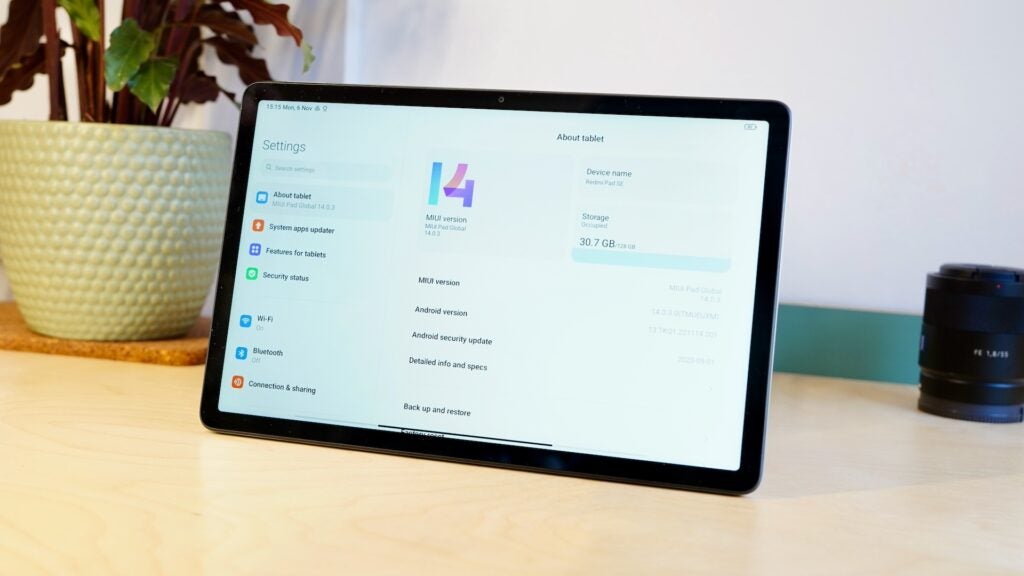
Is it me, or does that Google widget on the primary house display look weirdly small, like there’s been some sort of display scaling glitch? I’ve checked, and there doesn’t seem to have been. It’s simply one in every of many UI components that doesn’t fairly sit proper right here.
Xiaomi is about to ditch MIUI fully and begin afresh, so hopefully it’s received one thing higher up its sleeve. Whether or not low-cost units just like the Redmi Pad SE will profit from that improve stays to be seen, however there may be the promise of two years of OS updates, so you need to hope that it’ll.
Battery Life
- 8000mAh battery
- 10W charging help (provided)
- Very gradual charging certainly
Xiaomi has packed its finances pill with a big 8000mAh battery, which partially explains that additional thickness and weight in comparison with a few of its rivals.
It pays off too, with the sort of stamina that doesn’t appear to dissipate over a number of days of sunshine utilization, even with the show set to go as much as 90Hz.
When it comes to sensible duties, the Redmi Pad SE misplaced simply 5% of a cost when watching an hour of Netflix, whereas half-hour of sunshine gaming (Slay the Spire if you happen to’re questioning) didn’t even drop the gauge under 100%.
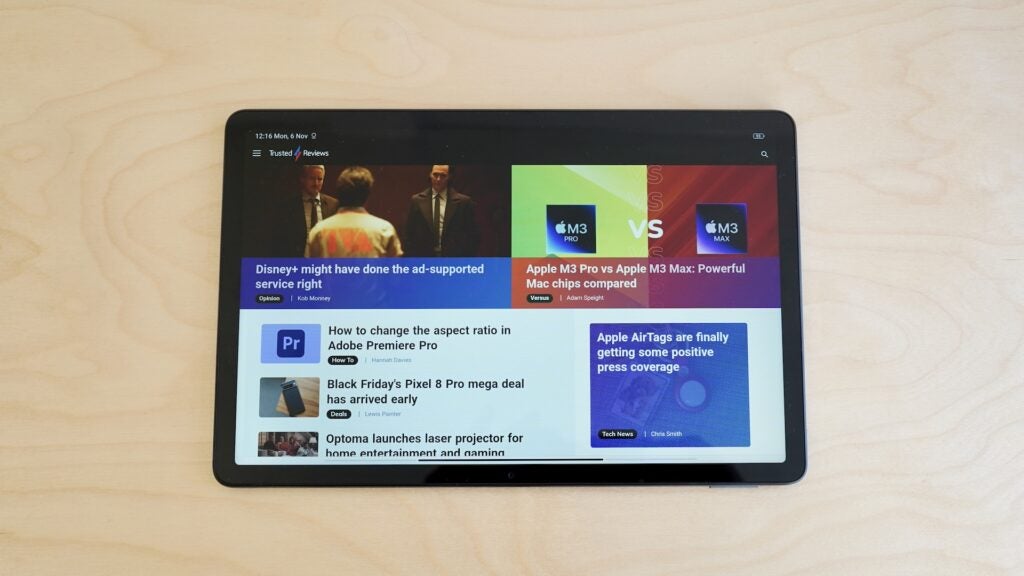
It’s an excellent job the stamina is so sturdy, as a result of the Redmi Pad SE solely helps as much as 10W wired charging. For such a big battery, that’s terrible, and just about necessitates an in a single day cost.
Having run the Redmi Pad SE proper down, a 15-minute cost solely received it again as much as 9%. It took 1 hour and 37 minutes to hit 50%, and a staggering 3 hours and 38 minutes to hit 100%.
After all, such sluggish charging speeds are much more acceptable in a pill than they’re in a smartphone. However with rivals just like the Oppo Pad Air supplying you with an 18W charger (which remains to be removed from fast), that is undeniably under par.
Newest offers
Must you purchase it?
You desire a respectable media-playing pill for lower than £200
The Redmi Pad SE gives you a strong streaming expertise for lower than £200, with a reliable display and respectable audio system.
You desire a pill that does all the things nicely
Media playback and internet searching apart, the Redmi Pad SE isn’t a really sturdy performer.
Remaining Ideas
At a value of simply £199 – and certain cheaper, given Xiaomi’s love of a sale – the Redmi Pad SE is among the most inexpensive full-sized tablets available on the market.
It actually appears to be like and seems like a costlier pill, with a tidy all-metal construct. Its show is massive and fluid too, and along with good quad audio system, it’s an honest transportable video streaming instrument.
Particular point out, too, for the Redmi Pad SE’s stamina, which is able to carrying you thru a number of days on a single cost.
Nonetheless, hamstrung efficiency, sluggish charging, and mediocre software program hold this pill feeling its price ticket everytime you attempt to do a lot past easy streaming. It’s helpful, however in a really restricted sense.
How we check
In contrast to different websites, we totally check each product we evaluate. We use industry-standard assessments with a view to evaluate options correctly. We’ll all the time inform you what we discover. We by no means, ever settle for cash to evaluate a product. Inform us what you assume – Ship your emails to the Editor.
Used as a essential system for per week
Benchmarked with industry-standard instruments
FAQs
It’ll stand as much as a number of days of sunshine to average utilization, whereas an hour of Netflix solely drains 5%.
It refreshes at a most 90Hz, which is among the smoother screens at this value.
The Redmi Pad SE runs on the Snapdragon 680, which is a reasonably low-end chip.
Trusted Opinions check knowledge
[ad_2]
Source link









































